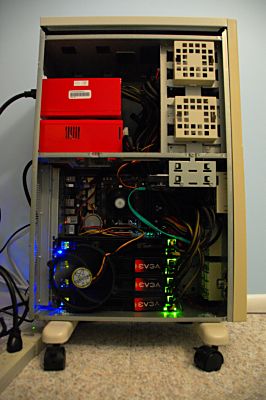
Gauri is a workstation I built in January 2009. Now that I've entered the modern era of SATA, DVI, and 64-bit processors, I wanted a second PC that I could use to play around with new software and technologies without causing any downtime to Aparna, my primary desktop. I also wanted a box powerful enough to make an impact with various distributed computing projects like Folding@home.
Because Gauri is my primary Folding@home box right now, all the fans are running full-speed and are very loud. I moved it out of my office and into the guest bedroom, which means it's mainly a headless server. Rather than testing client software, I'm going to use it to test things like SQL Server 2008 (where the 64-bit OS and 8GB of RAM will come in very handy).
Gauri means "golden, yellow, shining, brilliant" in Sanskrit. Like the rest of my PC names, it is another name for the Divine Mother, Shiva's consort in Hinduism.
I only did a minimal amount of research before building this machine, mostly on the [H]ard|OCP Distributed Computing forum. I wanted to run multiple graphics cards for GPU power, so I chose the popular MSI K9A2 because of the four well-spaced PCI-E x16 slots. That meant getting an AMD CPU, so I picked the Phenom II because of its large cache, and because it's relatively cheap even for a top-of-the-line CPU. The 9800 GX2 cards were chosen for maximum bang-for-the-buck. I went with 750W power supplies because at first I only had one 9800 GX2 and wasn't sure when I would find more, but I knew I could add a second PSU for more cards. That was much cheaper than buying a kilawatt-plus PSU. Plus, the PC Power & Cooling PSUs have rear exhaust fans, which means they will stack well.
I reused some parts on hand to keep the overall cost down. The hard drive came from Durga (and before that Lalitha). The case is my "vintage" Addtronics case from Shakti, and the Shakti parts were transplanted to a mini-tower case just like Amba's. When setting up the system, I had it hooked to my KVM, but now I'm controlling it with LogMeIn.
I did some testing with a Kill A Watt, and the system under load draws almost exactly 980W, which is 100% capacity for a single Smart-UPS 1500VA. I got a second 1500, which is overkill, but it was actually cheaper than a 1000VA model. (The DLA1500 models were manufactured for distribution by Dell, and somehow they ended up at third party liquidators for cheap.) I ended up swapping the second 1500VA unit with the Smart-UPS 1000VA under my desk.
The Addtronics case isn't perfect, but I was able to jam all four graphics cards in with only some minor alterations to the bottom card. Addtronics makes a bracket for dual PSUs, but even though their website is up, I'm not sure if they're still in business. I decided to make my own bracket, which will also allow the bottom PSU to be reoriented so it's not upside-down. I also need to test the cards "naked" and see if they run any cooler.
I screwed up originally and bought Windows XP Home (32-bit). I forgot that graphics cards use part of the system address space, so with four 9800 GX2s installed, I only had 1GB of RAM left for Windows. After switching to x64, life is much better, and so far I haven't run into anything that doesn't work. I'm staying away from Vista for now because it has issues with multiple graphics cards. I was able to use XP Home on Girija, which has become my client software testing machine.
I'm using RivaTuner to set the graphics cards fan speeds to 100%, and running Folding@home and other distributed computing projects. With all eight GPUs folding, I can get between 28K and 43K PPD, depending on the work units. Right now I'm averaging around 34K PPD, just from this box.
There are a couple more pictures of Gauri on Photobucket